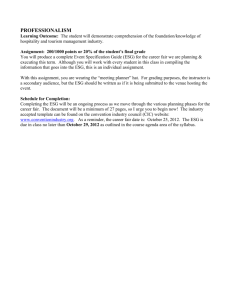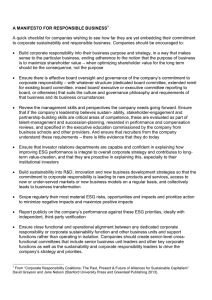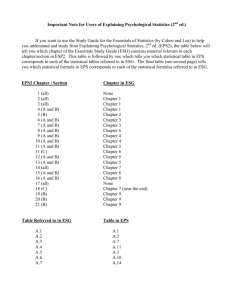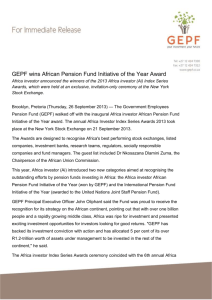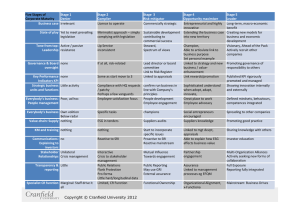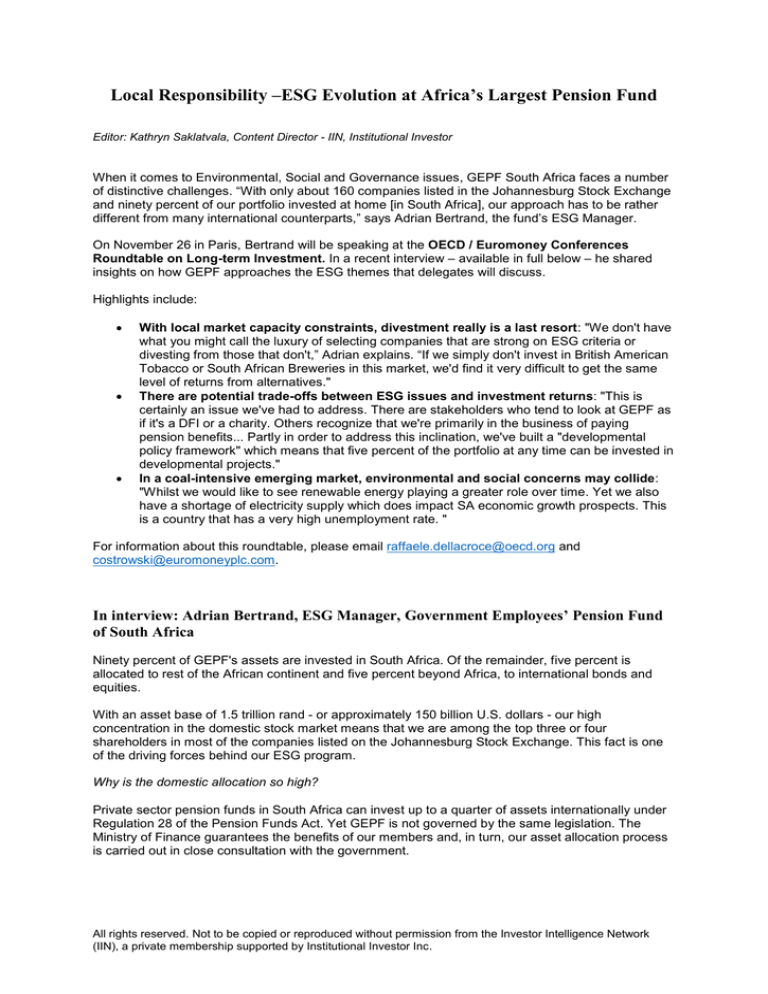
Local Responsibility –ESG Evolution at Africa’s Largest Pension Fund
Editor: Kathryn Saklatvala, Content Director - IIN, Institutional Investor
When it comes to Environmental, Social and Governance issues, GEPF South Africa faces a number
of distinctive challenges. “With only about 160 companies listed in the Johannesburg Stock Exchange
and ninety percent of our portfolio invested at home [in South Africa], our approach has to be rather
different from many international counterparts,” says Adrian Bertrand, the fund’s ESG Manager.
On November 26 in Paris, Bertrand will be speaking at the OECD / Euromoney Conferences
Roundtable on Long-term Investment. In a recent interview – available in full below – he shared
insights on how GEPF approaches the ESG themes that delegates will discuss.
Highlights include:
With local market capacity constraints, divestment really is a last resort: "We don't have
what you might call the luxury of selecting companies that are strong on ESG criteria or
divesting from those that don't,” Adrian explains. “If we simply don't invest in British American
Tobacco or South African Breweries in this market, we'd find it very difficult to get the same
level of returns from alternatives."
There are potential trade-offs between ESG issues and investment returns: "This is
certainly an issue we've had to address. There are stakeholders who tend to look at GEPF as
if it's a DFI or a charity. Others recognize that we're primarily in the business of paying
pension benefits... Partly in order to address this inclination, we've built a "developmental
policy framework" which means that five percent of the portfolio at any time can be invested in
developmental projects."
In a coal-intensive emerging market, environmental and social concerns may collide:
"Whilst we would like to see renewable energy playing a greater role over time. Yet we also
have a shortage of electricity supply which does impact SA economic growth prospects. This
is a country that has a very high unemployment rate. "
For information about this roundtable, please email raffaele.dellacroce@oecd.org and
costrowski@euromoneyplc.com.
In interview: Adrian Bertrand, ESG Manager, Government Employees’ Pension Fund
of South Africa
Ninety percent of GEPF's assets are invested in South Africa. Of the remainder, five percent is
allocated to rest of the African continent and five percent beyond Africa, to international bonds and
equities.
With an asset base of 1.5 trillion rand - or approximately 150 billion U.S. dollars - our high
concentration in the domestic stock market means that we are among the top three or four
shareholders in most of the companies listed on the Johannesburg Stock Exchange. This fact is one
of the driving forces behind our ESG program.
Why is the domestic allocation so high?
Private sector pension funds in South Africa can invest up to a quarter of assets internationally under
Regulation 28 of the Pension Funds Act. Yet GEPF is not governed by the same legislation. The
Ministry of Finance guarantees the benefits of our members and, in turn, our asset allocation process
is carried out in close consultation with the government.
All rights reserved. Not to be copied or reproduced without permission from the Investor Intelligence Network
(IIN), a private membership supported by Institutional Investor Inc.
From an investment return and liability management perspective, further flexibility would be helpful.
That being said, investing the majority of assets domestically does mean that we don't have to deal
with currency risks relating to our liabilities.
The ten percent international allocation (five percent Africa, five percent beyond) was approved
relatively recently, in late 2010. We now have a number of international and local asset managers
investing money outside of South Africa; our local partners need to gain further experience in this
area. We do hope this cap will be lifted further in future years so that we can invest more outside the
country. [Editor’s note: detailed asset allocation information can be found below.]
What does the external/internal asset manager program look like at GEPF?
Our principal fund manager, the Public Investment Corporation, manages the bulk of the GEPF
portfolio. This arrangement is fairly unique and it's unlikely that we'd ever remove their mandate. The
collaboration also involves working closely together on ESG issues. For example, if we have a
concern with a company in which we hold a stake through PIC, we'll have a joint meeting with our
ESG team and the PIC ESG team both present. They also have an internal ESG department of their
own, responsible for both listed and unlisted investments.
PIC manages assets for the GEPF across a range of asset classes, including the passive equity
program, some private equity, bonds, real estate, cash and money market funds.
As well as investing directly, the PIC also operates a multi-manager program with discretion to select,
appoint and review external fund managers on our behalf. In addition, we hire some other external
managers directly from GEPF. In total, we probably have around twenty external manager
relationships. This number also includes our emerging black manager program. This scheme is
designed to address the imbalances of apartheid, which resulted in a South African financial services
industry that is predominantly white-owned and white-managed. We cultivate black-owned asset
managers as part of our emerging manager program, allocating small mandates to each.
One question that we do consider is whether we may be using too many asset managers in the South
African market. With our size, we tend to find that the managers can cancel each other out overall.
When they outperform, we're outperforming ourselves. It's possible that the current number of
relationships might not be optimal and some consolidation may make sense in future.
What are the key aspects of GEPF’s ESG program?
Our ESG journey started with the GEPF signing up to the PRI in 2006. We're a very significant player
in the South African market, so of course many of our fund managers or would-be fund managers
here who wanted to get mandates from us got excited about PRI likewise and signed up - whether it
was for the right reasons or for marketing purposes. We helped to establish the PRI South African
Network to ensure that SA signatories were in fact implementing the 6 PRI principles and to assist in
attracting new asset owner signatories to the initiative.
Once we'd signed, we then began on the journey towards developing a responsible investing
implementation program, allocating both human and financial resources to this objective. I was
appointed in early 2011 to work on ESG matters, with two analysts working with me, reporting directly
to the investment committee once per quarter to advise them on what's happening from an active
ownership perspective.
GEPF and the PIC have developed an internal ESG matrix, used to analyze the top 100 companies in
the Johannesburg Stock Exchange, and we've partnered with the JSE on their strategy for dealing
with these issues. Following this partnership, we should be seeing some interesting changes at JSE
during the coming year with regards to the JSE ESG strategy to assist both issuers and investors
from an ESG data disclosure and performance viewpoint.
With only about 160 companies listed in the JSE and ninety percent of our portfolio invested at home,
our approach to ESG has to be rather different from many international counterparts. We don't have
what you might call the luxury of selecting companies that are strong on ESG criteria or divesting from
those that don't. If we simply don't invest in British American Tobacco or South African Breweries in
All rights reserved. Not to be copied or reproduced without permission from the Investor Intelligence Network
(IIN), a private membership supported by Institutional Investor Inc.
this market, we'd find it very difficult to get the same level of returns from alternatives. As a result,
divestment really is a last resort for us.
We prefer to hold management accountable, blocking resolutions at AGMs or opposing board
member nominations if need be. Given that a special resolution at a company AGM in SA requires a
75 percent majority shareholder vote, engagement for GEPF as a large minority shareholder means
working together with other shareholders to signal a long term investor view to the board and
management. South Africa is a small investment community and we have good relationships with our
asset managers.
Fund managers tend to be keener to collaborate on broader themes such as carbon taxes or
executive remuneration than on individual company-specific issues in the SA context.
For example, we're currently encouraging an initiative to make advisory votes on executive pay
binding rather than non-binding. South Africa unfortunately scores very highly on inequality rankings
with vast differences between average salaries and those of senior executives. International investors
and local asset managers are working with us on this issue.
On those occasions where there may be a trade-off between ESG considerations and returns, how do
you approach the challenge?
This is certainly an issue we've had to address. There are stakeholders who tend to look at GEPF as
if it's a DFI or a charity. Others recognize that we're primarily in the business of paying pension
benefits to South African civil servants upon retirement.
Partly in order to address this inclination, we've built a "developmental policy framework" which
means that five percent of the portfolio at any time can be invested in developmental projects, through
any type of asset class or instrument, as long as they do also meet a minimum return requirement in
excess of inflation. The four categories or "pillars" for these investments under the GEPF DI Policy
are:
1. Hard economic infrastructure, such as rail networks, roads, airport infrastructure, ports,
harbours and broad band ICT infrastructure
2. Social infrastructure including low-cost housing, healthcare, hospital infrastructure, education
3. Investments that help South Africa transition from a coal-based economy to a greener one,
such as investing in renewable energy projects.
4. Enterprise development, growing small business sectors and empowering black-run small,
medium and micro-sized businesses.
What happens when differing ESG factors conflict - for example where environmental concerns may
clash with social needs?
South Africa is a coal-intensive economy, whilst we would like to see renewable energy playing a
greater role over time. Yet we also have a shortage of electricity supply which does impact SA
economic growth prospects. This is a country that has a very high unemployment rate. The
government is concerned to ensure that electricity production is stable and grows to meet the needs
of an increasing consumer base. While a number of renewable energy projects have come to market,
the government is also building additional coal power plants. ESKOM, the government-owned
electricity provider, has recently suffered a downgrade in its credit rating, making it even more
challenging for them to issue debt.
This challenge is one reason why the proposed Carbon Tax - which would set a fee of 120 rand per
tonne of carbon emitted - has been delayed. We do support that tax, although it would significantly
impact the financial performance of the resource companies we own stakes in.
How does the ESG strategy for unlisted investments compare with listed investments?
Given that the private equity allocation of GEPF is relatively new, we're still putting in place structures
for regular reporting on ESG issues on that side of the portfolio. Small companies have limited
All rights reserved. Not to be copied or reproduced without permission from the Investor Intelligence Network
(IIN), a private membership supported by Institutional Investor Inc.
resources and the staff haven't traditionally focused on these issues, so it takes time to introduce new
processes. Developmental indicators are being created. As a result, I perhaps have more confidence
in the current ESG program for listed equities than for alternatives. Yet we're working closely with
partners to ensure that these issues are increasingly being managed and reported on to the GEPF
board.
Building the unlisted portfolio is a priority for GEPF at the moment. On the African continent, we have
something of a bias towards infrastructure; in South Africa, to a more traditional private equity
structure with a developmental focus.
Listed markets across the continent aren't very deep or liquid compared to our market and five
percent of a fund as large as this one is a very significant figure. As a result, building unlisted
exposure is particularly important to our strategy for reaching the five percent Africa allocation. We're
currently an anchor investor in the USD600 million first Pan African Infrastructure Development Fund
(PAIDF) and have committed money to the second. In addition, we're looking to partner with South
African listed companies that have strong operations on the continent, such as retailers that may
require retail infrastructure.
We're committed to helping other African economies develop, as we are here in South Africa. Africa
has an infrastructure deficit. In Nigeria, everyone needs a diesel generator because the national grid
can't meet demand. ESG considerations are high in our mind. One social angle is that we'd like to see
the emergence of more African-owned African-managed private equity funds on the continent, rather
than sending money to London for investment in Africa.
The Government Employees’ Pension Fund at a glance:
GEPF is the largest pension fund in Africa with assets under management worth more
than R1.5 trillion (around $150 billion depending on exchange rates). It is a defined
benefit scheme and the government acts as guarantor.
The fund manages and administers pensions and other benefits for government
employees in South Africa. With more than 1 279 000 active members and fewer than
400, 000 pensioners and beneficiaries, this is a relatively young plan.
Asset allocation:
Asset class
Lower limit
%
Upper limit
%
0%
26%
3%
Approved asset
allocation
%
4%
31%
5%
Cash
Domestic bonds
Domestic property
Domestic equity
45%
50%
55%
African (ex SA) equity
Foreign bonds
Foreign equity
0%
0%
1%
5%
2%
3%
5%
4%
5%
8%
36%
7%
Contact the editor:
Kathryn Saklatvala, ksaklatvala@iilondon.com, +44 20 7303 1726
All rights reserved. Not to be copied or reproduced without permission from the Investor Intelligence Network
(IIN), a private membership supported by Institutional Investor Inc.


